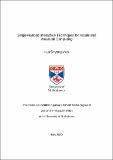Files in this item
Single-handed interaction techniques for mobile and wearable computing
Item metadata
| dc.contributor.advisor | Quigley, Aaron John | |
| dc.contributor.author | Yeo, Hui Shyong | |
| dc.coverage.spatial | xv, 272, [48] p. | en_US |
| dc.date.accessioned | 2021-07-01T15:31:43Z | |
| dc.date.available | 2021-07-01T15:31:43Z | |
| dc.date.issued | 2021-06-30 | |
| dc.identifier.uri | https://hdl.handle.net/10023/23461 | |
| dc.description.abstract | The past decade has seen the proliferation of mobile and wearable computing devices into our everyday life. Such devices are now used throughout the day for both productivity and entertainment purposes. As a result, it is important that input techniques for these devices are efficient, effective and intuitive. Further, it is important that these techniques reflect the reality of common usage patterns. In particular, supporting single-handed usage is of paramount importance, given that in many scenarios only one hand is available. As the screen size of mobile devices are getting larger, single-handed usage becomes even more problematic. At the opposite end of the scale, using small wearable devices such as smartwatches or fitness trackers often requires two hands. This thesis is concerned with the exploration, design, and evaluation of input techniques that enable practical and effective single-handed interaction on mobile and wearable devices, which empower users to achieve more with their smart devices when only one hand is available. In particular, the thesis focuses on the practicability and actual implementation of such techniques, by using built-in or low-cost sensors that are readily available. The work first motivates the thesis topic that was encountered during the early phase of study. Then, the single-handed interaction problem is tackled with two types of device form factor, both mobile and wearable. This thesis studies the problem on three types of input modalities – mid-air gesture, hand posture, on-surface gesture and three types of interaction techniques – text input, gesture, pointing. This thesis provides several techniques, interaction methods and exemplars required to explore the single-handed interaction problem. The effectiveness and efficiency of the techniques are evaluated with rigorous studies. | en_US |
| dc.language.iso | en | en_US |
| dc.publisher | University of St Andrews | |
| dc.relation | Opisthenar dataset UIST2019 (thesis data). Yeo, H.S., University of St Andrews, 10 Oct 2019. DOI: https://doi.org/10.17630/6ca91424-7f7f-4b7b-964b-bd2c3409aaaf | en |
| dc.relation.uri | https://doi.org/10.17630/6ca91424-7f7f-4b7b-964b-bd2c3409aaaf | |
| dc.subject | Single-handed | en_US |
| dc.subject | Interaction techniques | en_US |
| dc.subject | Wearable computing | en_US |
| dc.subject | Mobile computing | en_US |
| dc.subject.lcc | QA76.59Y4 | |
| dc.subject.lcsh | Mobile computing | en |
| dc.subject.lcsh | Wearable computers | en |
| dc.subject.lcsh | Human-computer interaction | en |
| dc.title | Single-handed interaction techniques for mobile and wearable computing | en_US |
| dc.type | Thesis | en_US |
| dc.type.qualificationlevel | Doctoral | en_US |
| dc.type.qualificationname | PhD Doctor of Philosophy | en_US |
| dc.publisher.institution | The University of St Andrews | en_US |
| dc.identifier.doi | https://doi.org/10.17630/sta/87 |
This item appears in the following Collection(s)
Items in the St Andrews Research Repository are protected by copyright, with all rights reserved, unless otherwise indicated.

